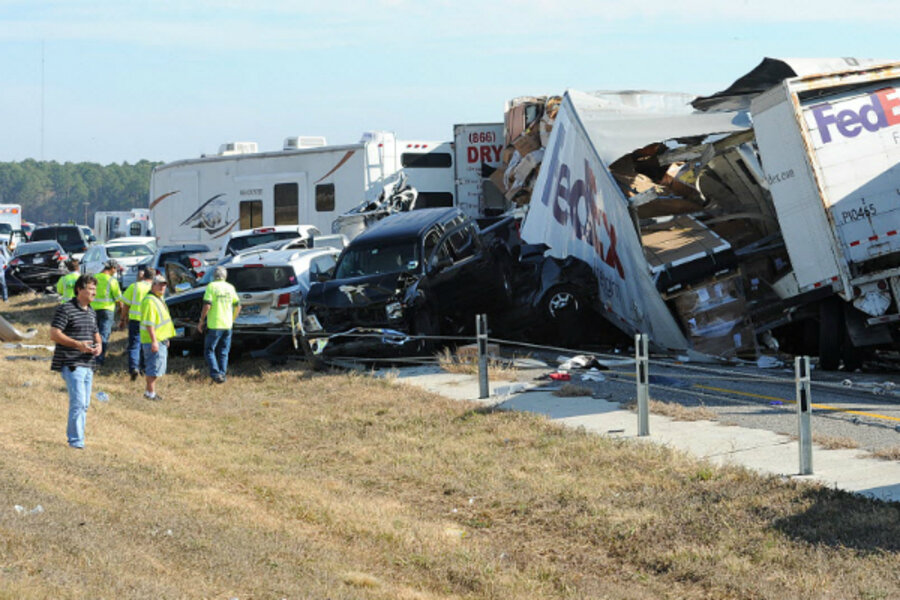Texas highway pileup: time to slow the ‘super truckers’ down?
| ATLANTA
While authorities have pegged thick Texas fog as the main culprit in the 140-car Thanksgiving pileup on I-10 just southwest of Beaumont, big rig truckers posting on Internet message boards suggest that civilian and professional drivers maintaining potentially reckless speeds, despite the conditions, may have been another major contributing factor.
Crowded with motorists and tractor trailers, the I-10 phalanx was moving at near 70 miles per hour despite the pea soup fog that rolled in, authorities said. Texas and Utah are the only states that allow truckers to travel at 80 miles an hour, while most states only allow 65-mile-an-hour truck travel. California's truck speed limit is the lowest, at 55. Compounding speed with low visibility, the margin of error shrank to dangerous levels, truckers wrote.
“It’s a wonder there wasn’t one like that between Detroit and Grand Rapids on 96 in the wee hours on Tuesday into Wednesday as many super truckers were flying by me in the pea soup non vis [non visibility] fog up there,” a rookie truck driver wrote on The Truckers Report website. “[Heck] of a choice though … run with them (or fast as I could anyway lol) and risk a wreck or slow to a safe speed and worry about getting rammed from behind.”
The I-10 Texas pile up was “even worse than last week on I-35, 4 rigs, 9 cars, 1 DOA,” another trucker wrote on the board. “I saw that one as the lifeflight was coming in. There have been several in a 10 mile part of I-35 under construction, all with fatalities. Guys PLEASE be careful.”
The Fatality Analysis Reporting System (FARS) recently reported that 25 percent of speeding-related large-truck fatalities occurred during adverse weather conditions, according to the Federal Motor Carrier Safety Administration.
To be sure, investigators are still looking into how the Beaumont pileup started and developed, though, as in the bulk of mega pileups, weather conditions were chiefly to blame, as a single mistake quickly multiplied with the limited visibility.
While statistics show that more than two-thirds of truck-passenger car crashes are the fault of the motorist, not the trucker, Texas authorities have confirmed that it was a tractor trailer that crashed into the SUV of a Pearland, Tex., couple that were killed in the massive Thanksgiving pileup. Truckers commenting on the crash also noted the prominence of several other tractor trailers in news pictures. The scene was chaos, with first responders overwhelmed and those unhurt from the crash scrambling to help survivors, many of them bleeding and at least 10 critically injured.
Drivers weighing in on the accident on various comment boards lamented the possible cultural dynamics of the crash. “Unless you’ve ever traveled here [in Texas], it’s hard for anyone to imagine how fast drivers in this state actually go,” one commenter wrote.
“Probably a better solution is to put a lower speed limit on those crazy big rigs,” a commenter on a CBS News story wrote on Friday. “The speed limit on 20 S of Midland is 80. I often travel this road and the big rigs just go flying past me. Those big heavy loads are hard to stop/slow down in an emergency. [The speed limit for trucks should be] 60 mph in Texas.”
But creating differential speed limits has its own problems. Studies have found that crashes increase when trucks drive slower than motorist traffic, and the Transportation Research Board has concluded that “a strong case cannot be made on empirical grounds in support of or in opposition to differential speed limits” for trucks and cars.
For now, Texas is leaning toward stepping on the gas, not the brake. The state legislature approved 85 mile per hour speed limits last year, and the first such stretch in the nation – a 41-mile Austin-San Antonio toll road – opened in September. (Congress ceded the speed argument to the states in1995, when it eliminated all federal restrictions on maximum speed limits.)






